DIY dry closet: a step-by-step guide to the construction of a peat dry closet
Dry closet - the so-called design designed to meet the natural physiological needs of a person. The dry closet is somewhat different from the usual home bathroom. Structures of this kind are in demand for use in conditions of temporary residence of people. For example, on a personal plot.
Any home master who knows how to hold simple carpentry tools in his hands will be able to arrange a comfortable dry closet for a summer house with his own hands. Therefore, the technology of its manufacture is of interest to many hacienda owners.
Before taking action, it is necessary to study the theoretical aspect of the technology of construction, agree? All necessary information is detailed in the article.
We described how the bio-closet is arranged and works, what materials are needed for assembly, and also provided step-by-step instructions for the manufacture and arrangement of a country toilet.
The content of the article:
The device and principle of operation of a typical dry closet
This type of toilets is characterized by a simple but interesting technology for processing the contents. The process of disposal of fecal waste is carried out exclusively by natural means. At the same time, organic substances, such as wood chips or peat, are used to enhance the process of natural processing (utilization).
Often, microflora created by artificial means is additionally used with these substances. Bioenzymes are also actively used - substances obtained from the vital activity of certain types of bacteria.
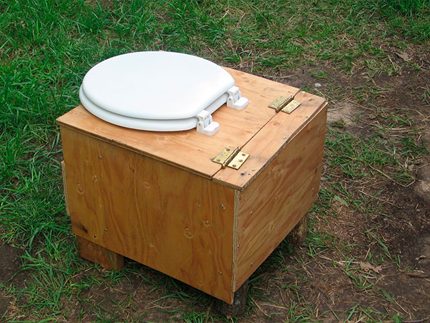
It is advisable to select a place where there is a minimum of drafts and protection from direct sunlight. Then the comfort for the user will be comparable to the comfort of a home toilet.
Before you get acquainted with the manufacturing technology and find out how to make a dry closet with your own hands, it is recommended to fully understand the essence of the device.
AND the essence of the dry closet following:
- The user is in need.
- The product of his life falls asleep in peat.
- Aerobic bacteria activate the composting process.
- The resulting compost matures for some time.
The finally ripened (decomposed) compost is a component rich in organic substances that are easily absorbed by plants. The conclusion for the summer resident is obvious: this product is an effective fertilizer for all types of vegetation of a private household.
Meanwhile, dry closets appear not only in summer cottages and on farms of private country houses. There are examples of the successful use of mobile structures of this kind, which are introduced on long-distance transport.
Railway trains and planes have long been equipped with dry closets. And the same type of structures, slightly modernized, appeared on sea yachts.
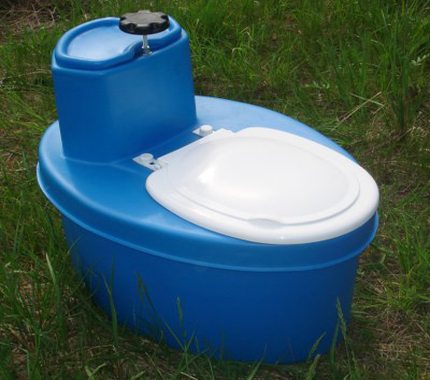
Considering do-it-yourself peat dry closets and alternative industrial options, we note an important nuance. Along with such designs, there are other types of “dry closets” that work exclusively on the principle of chemical processing of contents.
Both device designs are similar in external design, but the compost obtained through the chemical “need”, in principle, cannot be equated with natural fertilizers.
A comparative review of dry closets of different operating principles is given in this article.
The advantages of the peat type of country toilet include:
How to make a dry closet on your own?
The construction of this simple device, taking into account its temporary operation, can be divided into two possible construction options:
- Street construction without a house.
- Street construction with a house.
There are many recommendations on the network regarding the use of this peat recycling device directly inside the apartment building. But such an approach is unlikely to suit people too sensitive to odors.
True, if you take professionally made models of dry closets by masters, and not with your own hands, there is an opportunity to pick up a successful home version. In summer, in the summer cottage, the best place to place a natural peat utilizer is open air.
The option without a house provides for the manufacture of only a toilet seat paired with a storage box peat fillers. This is the simplest design solution possible.
Such a system is successfully operated, for example, in a summer cottage, the territory of which is reliably closed from prying eyes. A dry closet box is installed somewhere in a secluded place among the vegetation and is used if necessary.

The assembly of a biologically clean toilet does not indulge in particular difficulties. The process is quite affordable even for those who have never held a carpentry tool in their hands.
Materials, tools, sizes
To make a peat dry closet with your own hands, you will need the following materials:
- plywood sheets - thickness 10-12 mm;
- edged board - width 85-110 mm, thickness 12-15 mm;
- wooden block - section 40 * 40 mm;
- middle-sized door hinges - 6-10 pcs.;
- capacity of anticorrosive material - volume 10-12 l.
Need for working tools:
- hacksaw with a small tooth;
- sharp joiner's knife;
- bench hammer;
- screwdrivers, measuring tape, pencil;
- electric jigsaw;
- fasteners (nails, screws, screws).
The most difficult stage of independent work is cutting a round hole of large diameter on a pre-prepared plywood sheet.
Using a hacksaw, the plywood sheet is cut so as to obtain a panel with dimensions of 500 * 500 mm (specific dimensions directly depend on the dimensions of the future user).Then, a hole with a diameter of 250-300 mm is cut on the resulting square panel with an electric jigsaw.
Approximately such a blank should be obtained from a summer resident who decided to make a peat compact dry closet with his own hands:
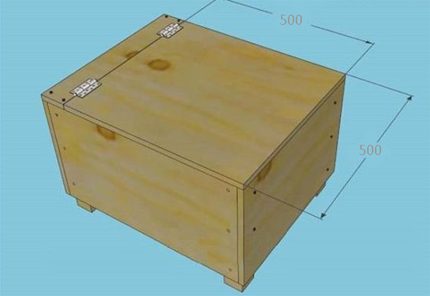
Having finished work with cutting, the plywood board is carefully cleaned with sandpaper. At the first stage of grinding, they use a large sandpaper, then continue grinding with a smaller one. The task is to get an even smooth surface of the plywood sheet.
It is enough to carry out grinding only on one side, which will be the outer panel of the seat seat. However, if possible, it is recommended to carry out the processing by grinding each part of the device.
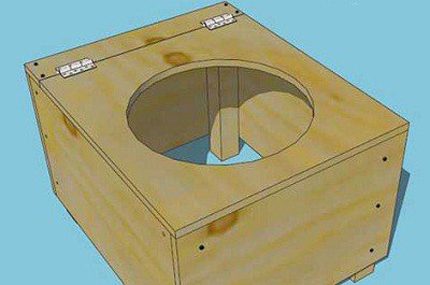
The fully finished product is equipped with an additional cover that closes the hole.
Next, you need to prepare a second plywood panel of the same size, but solid (without hole). She will play the role of a blank cover. Next, you need to cut to the size of the board for the assembly of the main box of the dry closet. The size of the length of the box should be taken equal to approximately two sizes of the length of the toilet seat (500 * 2 = 1000 mm).
The height size is selected based on the user's comfortable position when sitting on a chair. For people with different dimensions, this parameter may differ, but on average it is 350-400 mm. On the small side (width) of the rectangle, the estimated number of boards is also cut off.
Assembly of the utilizer body
A further continuation of the work on creating a peat dry closet with one's own hands is the assembly of a wooden rectangular case from prepared scraps of boards. The overall dimensions of such a box, respectively, are 1000 * 500 * 350 mm (length, width, height).
The boards are fastened to the bars, installing the latter at the internal corners of the structure. For fasteners, nails, screws or self-tapping screws are used.
The wooden case made in this way is divided inside by a partition. The result is two working sections.
One section is covered with a previously prepared plywood sheet with a hole and a trace of a continuous plywood cover. Another section (for peat storage) is covered with a lid, knocked down from the boards.
All covers are installed on the door hinges, thus ensuring their easy opening / closing. It turns out something similar to such a product of its own production.

At the final stage, the entire wooden structure is treated with an antiseptic. This action will prevent the appearance of fungal formations on the surface of the wood.
Also, antiseptic treatment will protect the structure from various insects. It remains only to place inside one section a container for collecting waste products from the owners of the summer residence, and fill the other section with peat. Homemade convenient dry closet is ready for use.
Toilet Accessories & Supplies
For the convenience of peat extraction from the neighboring section, it is recommended to make a small spatula. Homemade spatula is made of wood, but if you neglect the small costs, it is easier to buy a ready-made tool in the store. The plastic spatulas that retailers sell are lightweight, comfortable, but short-lived.
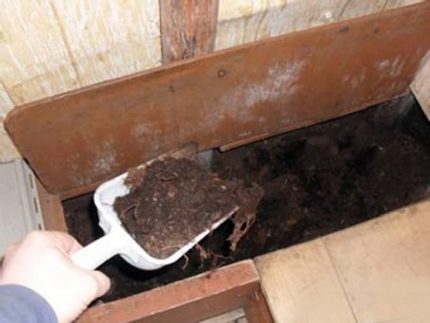
A container for collecting waste can be a regular bucket. But it is advisable to choose a more convenient and roomy container for these purposes. It is practical to use two containers of the same type, one of which should be stored nearby for quick replacement.
It is also recommended that you have accessories for cleaning the toilet and antibacterial agents on hand.
Additional equipment on the site
Waste that accumulates over time inside the toilet collection tank must be disposed of and carry out cleaning of the dry closet. For this, a compost pit is made near the installation site.
The pit volume is usually equal to ten times the volume of the collection tank, which is used in a peat dry closet. This ratio provides unhurried compost collection, its optimal ripening. This volume is enough to provide fertilizers with a summer cottage area of 2-4 acres.
Open toilets are rarely used in practice. As a rule, farm owners who decide to make a dry closet prefer to additionally build closed booths. Inside the enclosed cabins and is located the installation of natural recycling.
It’s not difficult to make a closed booth for a peat dry closet with your own hands. The assembly technology is standard, plus the material - edged boards, bars, fasteners. If desired, such a house can be supplemented with internal lighting, ventilation system and other attributes.
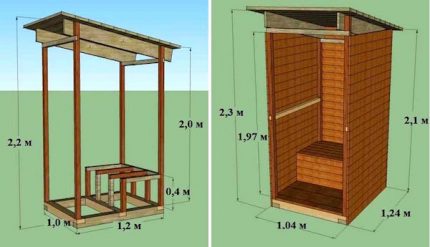
Using the additional equipment options, a self-assembled peat recycling system is easy to upgrade. Often, modernization boils down to replacing a makeshift toilet seat panel with a factory kit - toilet lid.
They also try to automate the manual adding of peat, using various metering schemes for this. True, difficulties already appear here for people who have little knowledge of technical mechanisms and do not have the corresponding experience. But if you want, you can do everything.
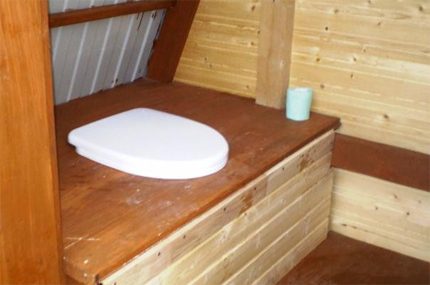
Wooden panels can be “frozen” in the color of mahogany, and the installation itself can be sheathed and a roof built over it. This will not be a temporary latrine, but a dry closet of constant use.
If there is no time and desire to build a bio-closet on your own, then you can choose the finished option.
Tips for choosing the best model for a summer house or a private home, as well as the rating of dry closets are given in the articles:
- How to choose a dry closet for a summer residence: a comparative review of the best models
- Rating of dry closets for a summer residence and a private house: a dozen popular + recommendations for customers
Conclusions and useful video on the topic
An interesting and useful video for those who want to replace the usual “corner of thought” with a dry closet:
There are many options for building biologically clean toilets. There are industrial designs made for samples of modern toilets. However, for the most part, the essence of the creation and operation of the dry closet is not at all in the comfort for the user.
This natural recycling tool is more specifically designed for use in conditions where there is no comfort, but where there is a need for the generation of high-quality fertilizers.
Have something to supplement, or have questions about arranging a dry closet in the country? You can leave comments on the publication, participate in discussions, share construction skills and attach photos of your homemade products. The communication unit is located below.

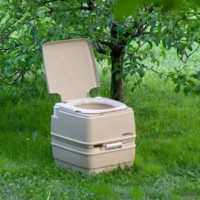 How to choose a dry closet for a summer residence: tips for choosing and an overview of the best models
How to choose a dry closet for a summer residence: tips for choosing and an overview of the best models  How to clean dry closets: features of cleaning peat and liquid varieties of dry closets
How to clean dry closets: features of cleaning peat and liquid varieties of dry closets 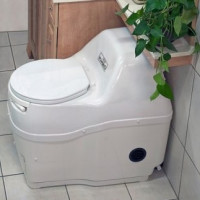 What is a dry closet: the principle of operation and the specifics of using autonomous plumbing
What is a dry closet: the principle of operation and the specifics of using autonomous plumbing 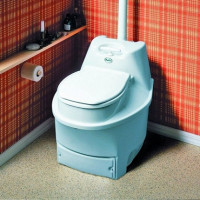 Rating of dry closets for a summer residence and a private house: popular models + recommendations for customers
Rating of dry closets for a summer residence and a private house: popular models + recommendations for customers 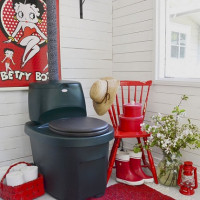 Which dry closet is better: liquid or composting? What to buy: peat or chemical option
Which dry closet is better: liquid or composting? What to buy: peat or chemical option  Do-it-yourself installation of metal gutters for the roof: technology analysis + installation example
Do-it-yourself installation of metal gutters for the roof: technology analysis + installation example  How much does it cost to connect gas to a private house: the price of organizing gas supply
How much does it cost to connect gas to a private house: the price of organizing gas supply  The best washing machines with dryer: model rating and customer tips
The best washing machines with dryer: model rating and customer tips  What is the color temperature of light and the nuances of choosing the temperature of the lamps to suit your needs
What is the color temperature of light and the nuances of choosing the temperature of the lamps to suit your needs  Replacement of a geyser in an apartment: replacement paperwork + basic norms and requirements
Replacement of a geyser in an apartment: replacement paperwork + basic norms and requirements
We were just thinking about something similar for a country house, until we decided to install a septic tank. There were contraindications to the construction of the treatment plant: clay soil, groundwater level is high. But a friend helped to choose a biological treatment station and resolve the situation. And while she was gone, they made a kind of toilet from the boards, but he was not bio. I did not know that waste could be used with such benefit. If you do it with the house, it’s generally gorgeous. But I do not recommend plastic substitutes to anyone, it’s better to make homemade products and use them on the farm!
You may ask, why do not you recommend plastic substitutes? We have already selected and ordered in the online store. According to reviews, it seems to be quite good (and the price is rather big), and it’s much easier to use it, as we were told. We just don’t have a man who himself could make something or suggest how to do it right. And with these cesspools oh how tired of messing around.
Do not pay attention, the plastic dry closet is quite normal. It does not rot, easy to clean, airtight. Of the minuses, only the price, but for a ready-made solution, it is quite possible to pay. Order, they bring to you and install. No worries.
In fact, all these are prejudices regarding plastic dry closets and containers. Perhaps the author of the comment has in mind that in plastic containers you need to use chemicals, although you can do with natural peat, for example. The article about this is also written in detail. In general, regarding plastic containers - this is a subjective criticism of one person, even without any arguments.
To warm the seat in cold weather, you can use a special cable or cut the seat out of foam. Both options are commercially available as ready-made solutions, and you can also make them yourself.